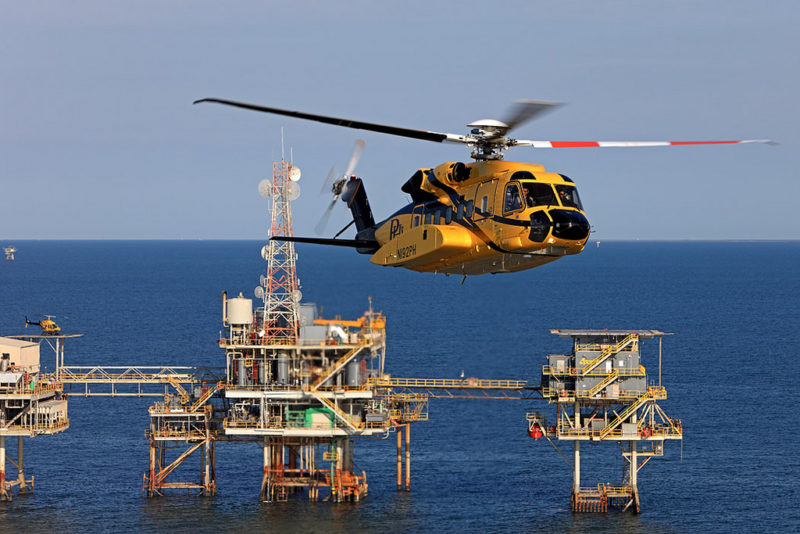
A PHI Sikorsky S-92A cruises past an oil rig in the Gulf of Mexico. Photo: Lockheed Martin
The annual Heli-Expo helicopter outlook released by Honeywell Aerospace estimates a global demand for 3,900 to 4,400 helicopters between 2017 and 2021. With a global estimated helicopter fleet of 25,000 rotorcraft currently in operation, the low outlook for new airframe purchases should lead to increased demand for aftermarket technology-focused upgrades.
Honeywell’s forecast excludes major helicopter fleet operators like PHI and Air Methods and others. But the survey still queries more than 1,000 chief pilots and operators of 3,746 turbine and 362 piston helicopters globally. Regionally, operators based in Latin America led all five regions surveyed in terms of the rate of new aircraft purchase plans for the second consecutive year, even though purchase plans in the region declined by more than 13% compared to last year’s forecast.
A number of different factors should continue to drive aftermarket demand for technology-focused upgrades though for operators. In the U.S., which in combination with Canada has the world’s largest helicopter fleet with more than 10,000 registered rotorcraft, helicopter operators are facing several upcoming airspace equipage mandates. These include the FAA’s requirement for emergency medical service-configured helicopters to be equipped with helicopter terrain awareness and warning systems (HTAWS) and flight data monitoring systems by April 24, 2017. Part 135 helicopter operators are also required to equip HTAWS and multifunction displays that feature radio altimeters and 406 MHz emergency locator transmitters (ELTs) by the same date. By Jan. 1, 2020, the majority of helicopters operating in U.S. airspace will also have to be equipped with FAA-compliant automatic dependent surveillance-broadcast (ADS-B) out avionics.
Beyond the mandated technology requirements, the new technologies companies will have on display at Heli-Expo this year reflect the type of demand they’re seeing. Charles Park, director of market analysis at Honeywell told Avionics that the operators they surveyed are influenced by range, cabin size, performance and technology upgrades when considering new helicopter purchases.
“Connectivity, safety and situational awareness — in some cases they’re interested in engine upgrades, although that’s a smaller portion of operators,” said Park. “A lot of that interest is predicated on new technology, performance gains, operating cost improvements.”
Connectivity and health and usage monitoring systems (HUMS) technology upgrades in particular should be in high demand for helicopter operators, based on the types of products companies are promoting this year at Heli Expo 2017. Companies have increasingly overcome the traditional problem associated with getting high-speed broadband connectivity to helicopters, which has historically been limited by the impact of rotor blades blocking satellite signals. But in recent years Honeywell, Rockwell Collins and satellite companies like Iridium have claimed to overcome this issue.
Honeywell, for example, recently released a video showing how its Aspire 200 SwiftBroadband system is capable of allowing iPhone FaceTime conversations between helicopter passengers and pilots and people on the ground. Honeywell also announced it was in the process of securing a supplemental type certificate (STC) for installation of the Aspire 200 system on the Airbus AS350, which the company believes can be beneficial for air medical and law enforcement helicopter communications.
Other companies have introduced new products enabling better helicopter connectivity as well. RUAG Aviation, for example, said it has obtained a new STC for enabling 4G LTE connectivity primarily for VVIP class helicopters. Schematics of the STC involve accessing ground-based 4G LTE networks via a dedicated antenna specifically designed for helicopters. The antenna then interfaces with an onboard router and wifi.
Thales also plans to unveil three new helicopter-focused technologies at the show. Elsewhere, with the launch of its “NEXT” satellite constellation under way, Iridium is working with satellite communications equipment providers on hardware that will enable connectivity through the NEXT satellites. This hardware also will include terminals designed for helicopters.
MRO provider JSSI’s latest report on its own helicopter maintenance programs shows increasingly more operators are keeping their helicopters longer and maintaining them with upgrades to keep up with current generation technology. According to another report released at Heli-Expo, JSSI saw a 250% increase in the number of new helicopter maintenance contracts it provided in 2016, with a 600% increase in the value of those contracts compared to 2015. The company also introduced 18 new helicopter maintenance programs in 2016 and plans on introducing another 10 this year.
One area where demand is low for connectivity-related HUMs equipment, particularly for engines, is in the light and single-engine category. StandardAero’s director of sales, marketing and business development, Brian Hughes, says his company’s maintenance repair and overhaul (MRO) business is seeing increased demand for HUMS technology for helicopter engines, but only in certain categories.
“In the light helicopter business, the operators are not willing to pay for that. It’s had success in the larger helicopters, but not on the light side,” said Hughes in a press conference Monday. “The technology is certainly there, it’s in our industry, but they’re not willing to put that kind of money into it.”
Another indication that companies could start seeing increased demand for new helicopter technology is that despite the lower fleet replacement and growth outlook, Honeywell reported that helicopter fleet utilization in the past 12 months generally increased compared to the previous year. Over the next 12 months, usage rates are expected to improve significantly in North America and Latin America, but at a reduced rate in Europe.
“Even in a slow growth environment, Honeywell is well-positioned to help operators keep current fleets lasting longer with aftermarket upgrades and repairs,” said Ben Driggs, president of Honeywell.